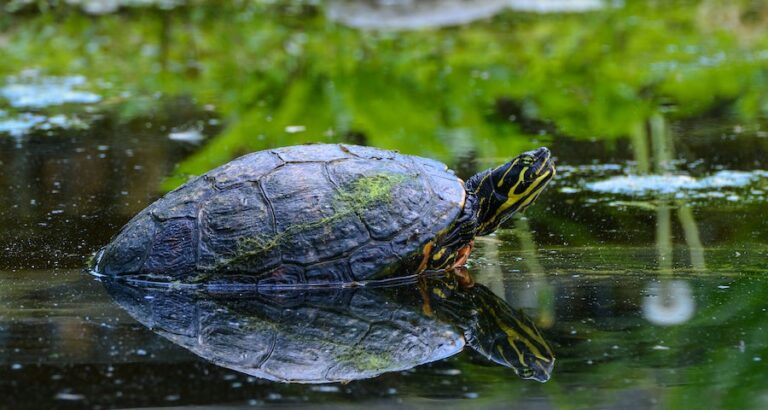Caring for European pond turtles, while they may be petite and manageable, demands dedicated attention for their long and vibrant existence. These charming turtles can become cherished companions for years with the right guidance.
To ensure your European pond turtle enjoys a healthy and joyful life, we’ve compiled an exhaustive handbook on optimal care. Within this comprehensive guide, we unveil six crucial insights that will elevate your mastery of European pond turtle care.
Table of Contents
Habitat
The foremost consideration in the care of European pond turtles is their habitat. These turtles thrive in semi-aquatic conditions, necessitating a harmonious blend of land and water elements. Constructing a suitable terrarium entails incorporating essential components such as a shallow water dish, a basking bulb, UVB lighting, and a sheltered retreat.
To replicate their natural surroundings effectively, it’s advisable to introduce aquatic flora, a filtration system, and a water heater into the aquatic section. It is crucial to maintain the cleanliness of the terrarium, a task that should be undertaken regularly to stave off bacterial proliferation in both the aquatic and terrestrial zones.
Additionally, one must remain attuned to the habitat’s size. As your turtle undergoes growth, it becomes imperative to expand the dimensions of the terrarium to guarantee it enjoys ample space without feeling cramped.
The overall rule of thumb for tank size is ten gallons per inch of turtle, so plan accordingly. Furthermore, the habitat should be placed in a quiet, low-traffic area of your home to minimize stress for the turtle.
Diet
The correct diet for European pond turtles is vital for their health and longevity. The foremost consideration in the care of European pond turtles is their habitat. These turtles thrive in semi-aquatic conditions, necessitating a harmonious blend of land and water elements.
Constructing a suitable terrarium entails incorporating essential components such as a shallow water dish, a basking bulb, UVB lighting, and a sheltered retreat. To replicate their natural surroundings effectively, it’s advisable to introduce aquatic flora, a filtration system, and a water heater into the aquatic section.
It is crucial to maintain the cleanliness of the terrarium, a task that should be undertaken regularly to stave off bacterial proliferation in both the aquatic and terrestrial zones.
Additionally, one must remain attuned to the habitat’s size. As your turtle undergoes growth, it becomes imperative to expand the dimensions of the terrarium to guarantee it enjoys ample space without feeling cramped.
Temperature
European pond turtles, being cold-blooded denizens of their habitat, rely on a meticulously crafted temperature spectrum to govern their bodily warmth. For optimal conditions, the basking locale should maintain a balmy range of 32-35°C, while the aquatic realm should embrace a cooler climate of 22-26°C. The presence of this temperature gradient emerges as a pivotal facet in orchestrating the harmonious functioning of their metabolism, digestion, and immune defenses.
Additionally, it’s critical to note that excessive temperature fluctuations can induce stress in these turtles, potentially leading to health complications. Therefore, maintaining a consistent temperature pattern is crucial, and any changes should be enacted gradually over time to avoid shocking the turtle’s system.
Lighting
UVB lighting is essential for a turtle’s health. It is required for proper calcium metabolism, which helps prevent metabolic bone disease. A 10-12 hour light cycle is recommended to mimic natural daylight hours.
Position the UVB light strategically within the habitat, ideally in close proximity to the basking zone for easy accessibility by the turtle. Vital to the welfare of your European pond turtle is the timely replacement of the UVB bulb, a chore that should be performed every six months or in accordance with the manufacturer’s guidance.
This upkeep is crucial as the potency of UVB emission diminishes with the passage of time, and ensuring its effectiveness remains paramount for the turtle’s well-being.
Hydration
Keeping your European pond turtle hydrated is crucial, and it should have access to clean water. Ensure that the water dish is thoughtfully designed, offering a shallowness that facilitates the turtle’s effortless ingress and egress. A daily ritual should involve the renewal of the water supply, diligently guarding against the presence of any chemical additives like chlorine.
Furthermore, vigilance must extend to the monitoring of humidity levels within the turtle’s sanctuary. Low humidity levels hold the potential to induce dehydration, underscoring the need for periodic assessments to maintain the turtle’s well-being.
Providing a soaking dish with water can also assist in maintaining adequate hydration levels, support shedding, and promote overall skin health.
Healthcare
Regular vet visits, annual checkups, and fecal exams can help detect any health issues early on. European pond turtles can contract some bacterial and fungal infections, especially if their habitat or diet is not properly taken care of. Early detection allows for prompt treatment.
In addition to professional veterinary care, it’s crucial for owners to conduct regular inspections at home, checking for any changes in the turtle’s behavior, eating habits, or physical appearance. These at-home check-ups can help spot potential health problems between vet visits, adding an extra layer of protection to your pet’s health regime.
Conclusion about European Pond Turtle Care
In conclusion, properly caring for your European pond turtle means providing a suitable habitat, a balanced diet, appropriate temperatures, UVB lighting, access to clean water, and proper healthcare.
When all these prerequisites are met, you can take comfort in the knowledge that your European pond turtle will not only flourish but also enjoy a prolonged and robust existence. Patience and unwavering consistency in your care routines are key. In return, your turtle will bestow upon you years filled with affection and unwavering companionship.

